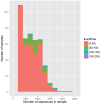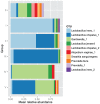Characterization of the vaginal micro- and mycobiome in asymptomatic reproductive-age Estonian women
- PMID: 23372716
- PMCID: PMC3553157
- DOI: 10.1371/journal.pone.0054379
Characterization of the vaginal micro- and mycobiome in asymptomatic reproductive-age Estonian women
Abstract
The application of high-throughput sequencing methods has raised doubt in the concept of the uniform healthy vaginal microbiota consisting predominantly of lactobacilli by revealing the existence of more variable bacterial community composition. As this needs to be analyzed more extensively and there is little straightforward data regarding the vaginal mycobiome of asymptomatic women we aimed to define bacterial and fungal communities in vaginal samples from 494 asymptomatic, reproductive-age Estonian women. The composition of the vaginal microbiota was determined by amplifying bacterial 16S rRNA and fungal internal transcribed spacer-1 (ITS-1) regions and subsequently sequencing them using 454 Life Sciences pyrosequencing. We delineated five major bacterial community groups with distinctive diversity and species composition. Lactobacilli were among the most abundant bacteria in all groups, but also members of genus Gardnerella had high relative abundance in some of the groups. Microbial diversity increased with higher vaginal pH values, and was also higher when a malodorous discharge was present, indicating that some of the women who consider themselves healthy may potentially have asymptomatic bacterial vaginosis (BV). Our study is the first of its kind to analyze the mycobiome that colonizes the healthy vaginal environment using barcoded pyrosequencing technology. We observed 196 fungal operational taxonomic units (OTUs), including 16 OTUs of Candida spp., which is more diverse than previously recognized. However, assessing true fungal diversity was complicated because of the problems regarding the possible air-borne contamination and bioinformatics used for identification of fungal taxons as significant proportion of fungal sequences were assigned to unspecified OTUs.
Conflict of interest statement
Figures





References
-
- Klebanoff SJ, Hillier SL, Eschenbach DA, Waltersdorph AM (1991) Control of the microbial flora of the vagina by H2O2-generating lactobacilli. J Infect Dis 164: 94–100. - PubMed
-
- Schwebke JR (2001) Role of vaginal flora as a barrier to HIV acquisition. Curr Infect Dis Rep 3: 152–155. - PubMed
-
- Donders GGG, van Calsteren K, Bellen G, Reybrouck R, van den Bosch T, et al. (2009) Predictive value for preterm birth of abnormal vaginal flora, bacterial vaginosis and aerobic vaginitis during the first trimester of pregnancy. BJOG 116: 1315–1324. - PubMed
-
- Antonio MA, Hawes SE, Hillier SL (1999) The identification of vaginal Lactobacillus species and the demographic and microbiologic characteristics of women colonized by these species. J Infect Dis 180: 1950–1956. - PubMed
Publication types
MeSH terms
Substances
LinkOut - more resources
Full Text Sources
Other Literature Sources
Research Materials
Miscellaneous

